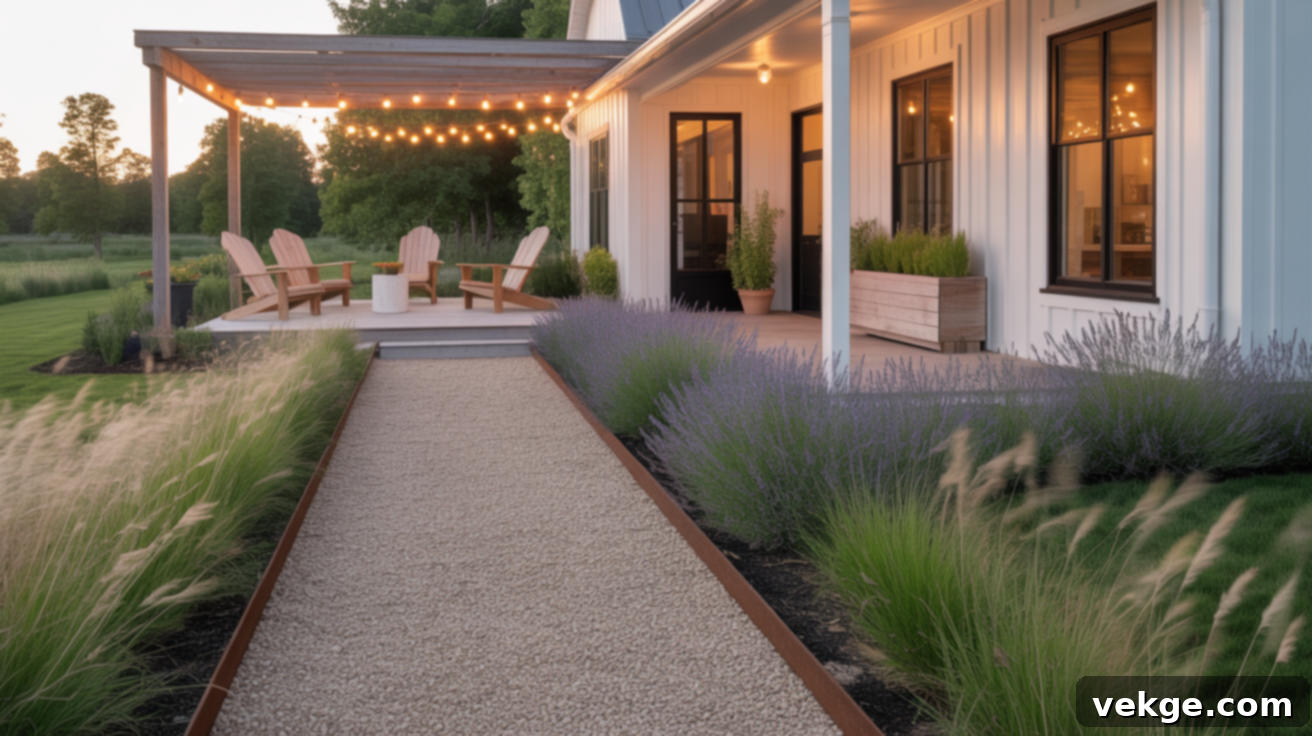Transform Your Outdoor Space: The Ultimate Guide to Modern Farmhouse Landscaping Ideas
Creating an outdoor sanctuary that feels both invitingly cozy and refreshingly clean has always been a dream of mine. For many, the challenge lies in knowing where to begin. That’s precisely why I embarked on a journey into the world of modern farmhouse landscaping, a style that perfectly balances rustic charm with contemporary simplicity.
In this comprehensive guide, I’ll share my most cherished tips and actionable advice covering everything from selecting the right plants and crafting elegant pathways to implementing budget-friendly updates. Whether you’re starting from scratch with a new yard or looking to revitalize an existing space, these ideas are designed to help you cultivate an outdoor environment you’ll genuinely love and enjoy.
Let’s explore how thoughtful, small changes can collectively create a significantly impactful and beautiful modern farmhouse landscape.
Understanding Modern Farmhouse Landscaping: A Perfect Blend of Old and New
Modern farmhouse landscaping is more than just a style; it’s a philosophy that harmoniously blends the timeless charm of rustic farm elements with the crisp, streamlined aesthetics of modern design. This unique approach celebrates functionality, comfort, and a deep connection to nature, resulting in outdoor spaces that feel both authentic and sophisticated.
The essence of this style lies in its ability to combine weathered, natural materials and resilient native plants with simple, uncluttered layouts and minimalist features. The outcome is a landscape that feels fresh and current, yet deeply rooted in classic, enduring beauty. Emphasis is placed on creating functional, “lived-in” spaces, often utilizing reclaimed materials and low-maintenance plantings to ensure sustainability and ease of care.
Practical touches, such as dedicated kitchen gardens for fresh produce or comfortable outdoor seating areas for relaxation and entertaining, elegantly reflect traditional farming roots while perfectly addressing the needs of a contemporary lifestyle. It’s about creating an outdoor extension of your home—a space that invites you to relax, entertain, and connect with the natural world.
Key Elements of Modern Farmhouse Landscaping
Achieving the distinctive modern farmhouse aesthetic in your yard involves carefully integrating several core design elements. These components work together to create a cohesive, balanced, and appealing outdoor environment.
1. Neutral Tones and Clean Lines
These two elements form the fundamental foundation of any modern farmhouse yard. A palette of soft whites, warm grays, and natural earthy colors ensures the landscape remains grounded, relaxed, and welcoming. These soothing hues provide a serene backdrop that allows natural textures and plant colors to truly shine. Paired with these tones, straight lines, simple geometric shapes, and defined edges introduce structure and order without feeling rigid. This combination keeps the look refined and sophisticated. By avoiding overly trendy or vibrant colors, you ensure your landscape possesses a timeless quality, maintaining its beauty and cohesive appeal for years to come.
2. Natural Textures for Depth and Interest
Incorporating a variety of natural textures is crucial for giving your modern farmhouse yard depth, character, and visual interest. Materials like weathered wood, rugged stone, and industrial metal introduce a tactile dimension that invites interaction. Consider using cedar, cypress, or beautifully aged reclaimed boards for fencing, sturdy raised garden beds, or charming accent walls. These woods bring warmth and a sense of history. To create balance, mix in smooth river rocks, permeable limestone paths, or sleek black steel planters. This interplay of soft and hard textures ensures the landscape feels rich and layered while maintaining its clean, modern structure.
3. Prairie and Native Plants: Beauty with Purpose
The choice of plants is integral to defining the modern farmhouse aesthetic, leaning heavily towards prairie-style and native species. Plants such as vibrant coneflowers (Echinacea), graceful feather reed grass, and fragrant lavender offer a dynamic combination of color, texture, and seasonal variety. Beyond their undeniable beauty, these plants are functional: they support healthy soil ecosystems, attract vital pollinators like bees and butterflies, and are remarkably drought-tolerant, requiring less water and maintenance once established. Their natural, unpretentious beauty contributes to a relaxed and authentic landscape that thrives with minimal intervention, reflecting a practical, sustainable approach to gardening.
4. Bold Black and White Contrast
The striking contrast of black and white adds a crisp, contemporary definition to your outdoor design, serving as a signature element of the modern farmhouse style. This high-contrast pairing creates visual drama and highlights architectural features. Imagine dark trim on windows and doors, stylish black outdoor chairs, or minimalist steel planters set against bright white siding, light gravel paths, or freshly painted fences. This powerful juxtaposition accentuates clean, modern edges, while the softer forms and natural colors of nearby plants prevent the overall look from feeling too sharp, stark, or cold. It’s a sophisticated way to ground your design.
5. Reclaimed or Rustic Materials: A Story in Every Piece
Introducing reclaimed or rustic materials imbues your landscape with a unique charm and a palpable sense of history. Elements like weathered old barn doors, vintage metal troughs, or salvaged bricks tell a story, adding unparalleled character and a touch of sustainable elegance. Beyond their aesthetic appeal, using these materials helps reduce waste and gives new life to forgotten items. It’s important to use them thoughtfully and sparingly, allowing each piece to serve as a distinctive focal point. This approach prevents clutter and ensures that every reclaimed item contributes its quiet, authentic character to your outdoor space, making it truly one-of-a-kind.
Inspiring Modern Farmhouse Landscaping Ideas for Your Home
Through my own landscaping journey, I’ve discovered that the magic of modern farmhouse design lies in its ability to combine rustic warmth with clean, contemporary lines. This fusion creates a yard that’s not only beautiful and inviting but also surprisingly simple and easy to maintain. You can achieve this coveted look without overthinking it, and the results are truly rewarding. Here are some inspiring ideas to get you started.
Pathways and Driveways: Guiding Your Journey
These functional routes are crucial for guiding movement through your property, while simultaneously establishing a strong modern farmhouse character through carefully selected materials and thoughtful design.
1. Gravel Pathways with Metal Edging
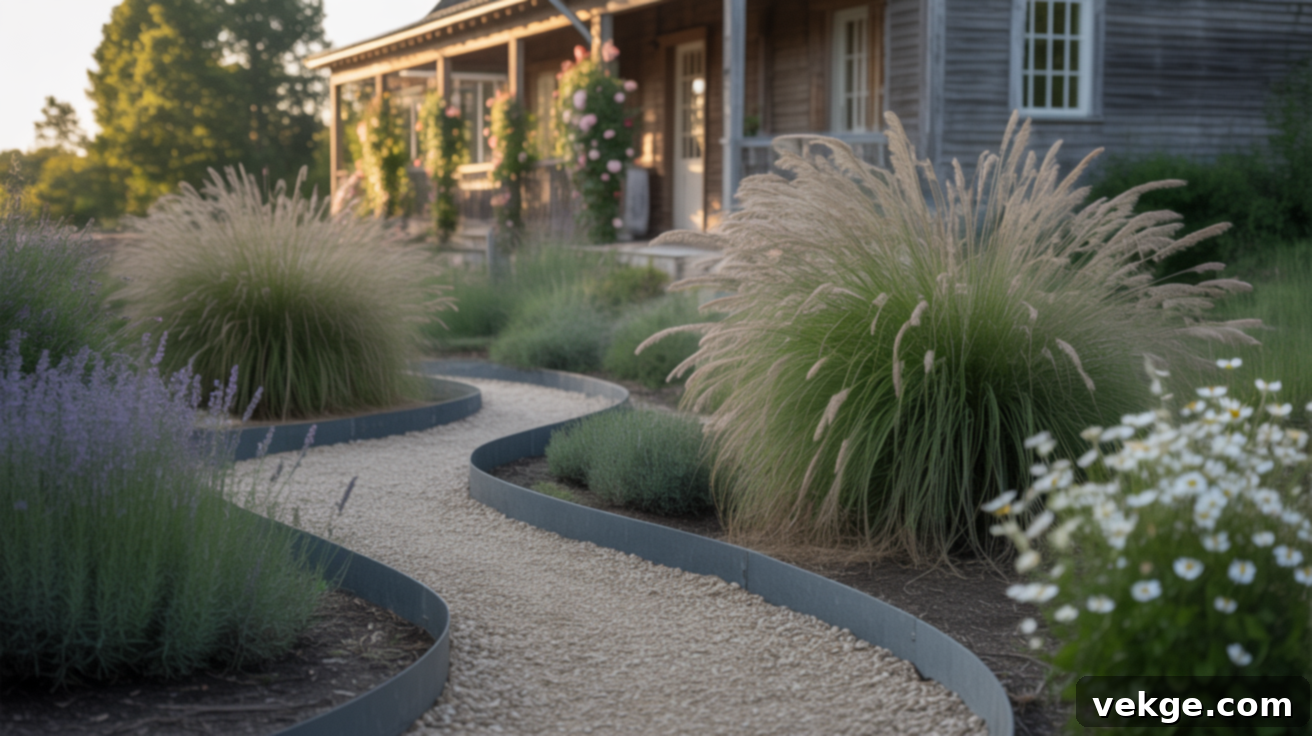
Crushed limestone, pea gravel, or decomposed granite creates informal yet elegant pathways that are both permeable and incredibly functional. They drain exceptionally well and provide a satisfying crunch underfoot, adding an auditory element to your stroll. The loose material introduces a soft, organic texture to the landscape, while crisp metal edging (such as steel or aluminum) maintains a clean, structured appearance, preventing the gravel from spreading and clearly defining the path’s borders. This combination offers both rustic appeal and modern precision.
2. Stone or Brick Front Walkway
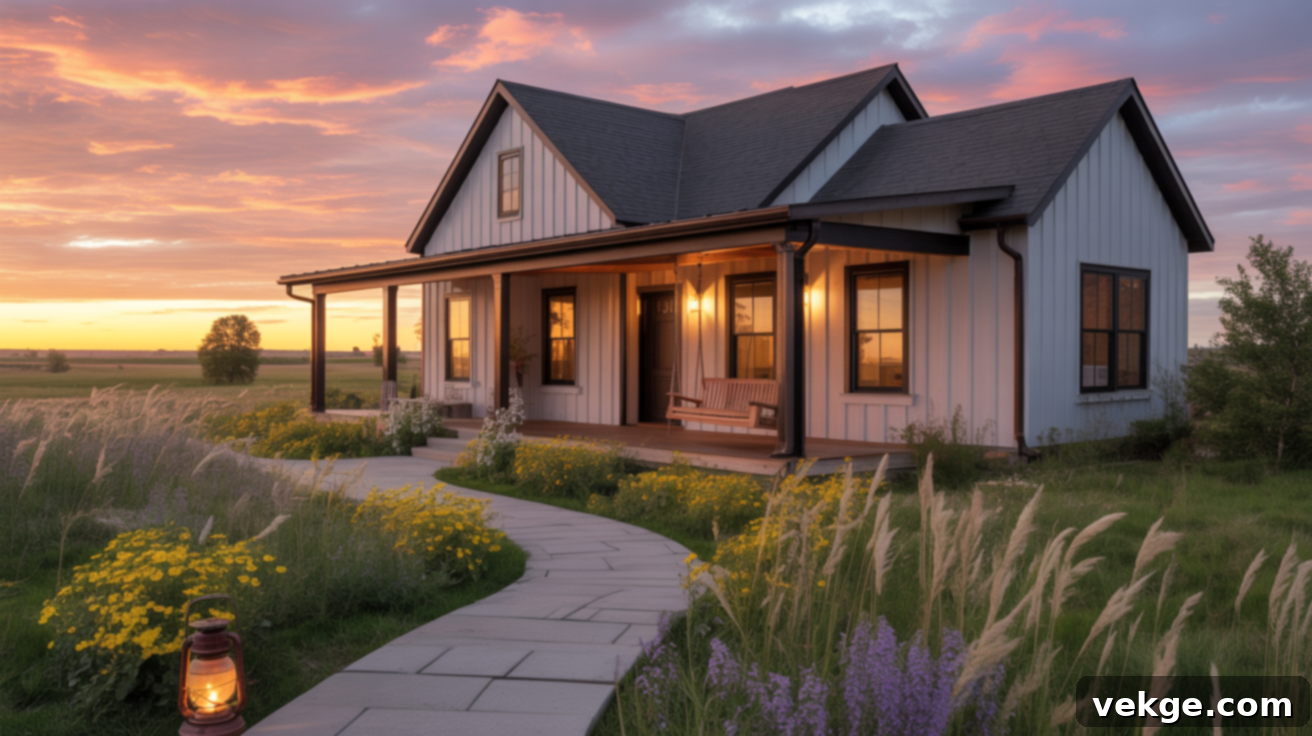
A front walkway crafted from natural stone pavers or classic bricks provides a timeless and established approach to your home’s entrance. Opt for soft-edged bluestone, versatile flagstone, or durable limestone slabs laid in irregular, organic patterns or a traditional herringbone brick pattern. These materials complement a wide range of architectural styles, from traditional farmhouses to more modern residences. Setting them in a bed of gravel or sand allows for natural drainage and a slightly more casual, inviting feel.
3. Crushed Rock Driveway with Grass Strip
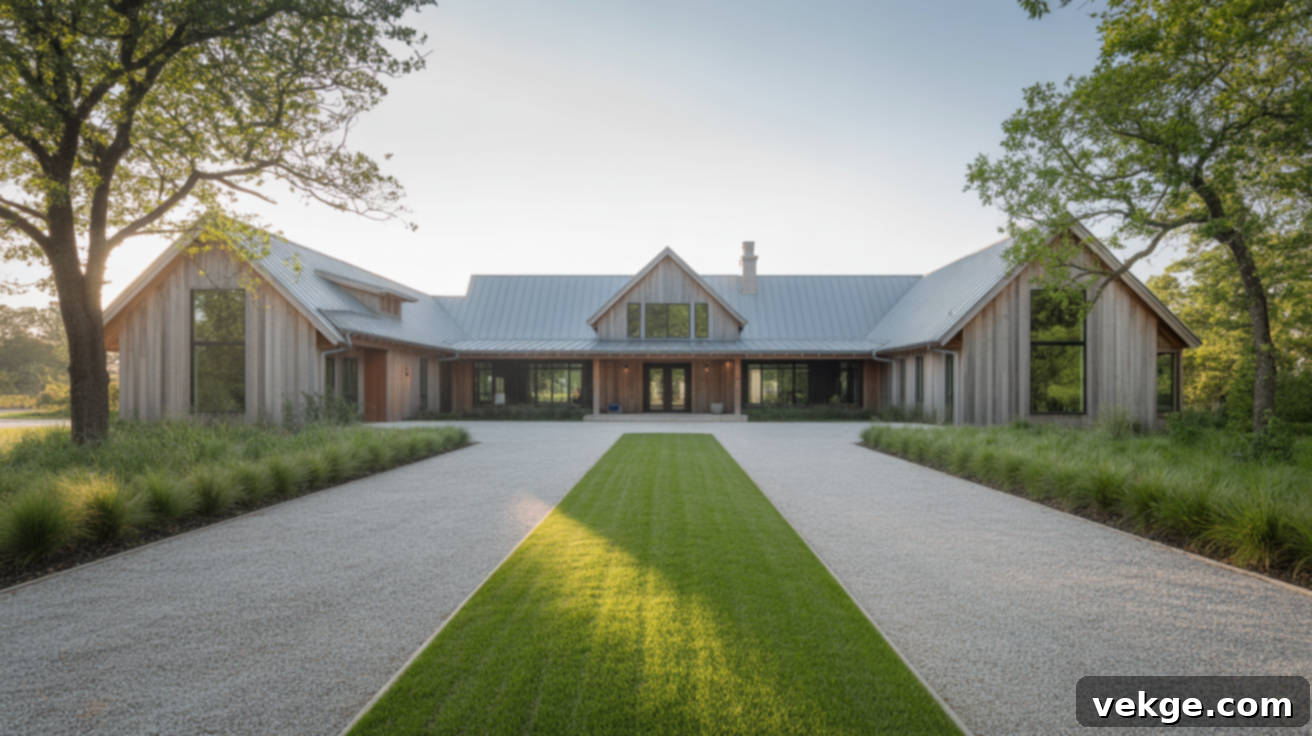
Crushed rock driveways strike a perfect balance between rustic appeal and practical functionality. They offer excellent drainage, reduce impervious surfaces, and create that characteristic satisfying crunch under tires. Enhancing this, a central grass strip woven through the driveway adds significant visual softness and a welcoming touch. This design choice elevates the driveway from a purely utilitarian feature to an inviting approach that feels deeply established and integrated into the landscape, rather than merely a hard, unyielding surface. Consider low-growing, durable grasses for the strip.
Garden Beds and Planters: Defined Beauty
These defined growing spaces are essential for showcasing plants while adding structure and visual interest. Through farmhouse-inspired materials, thoughtful arrangements, and strategic container choices, they significantly enhance your overall landscape design.
4. White Planter Boxes with Black Trim
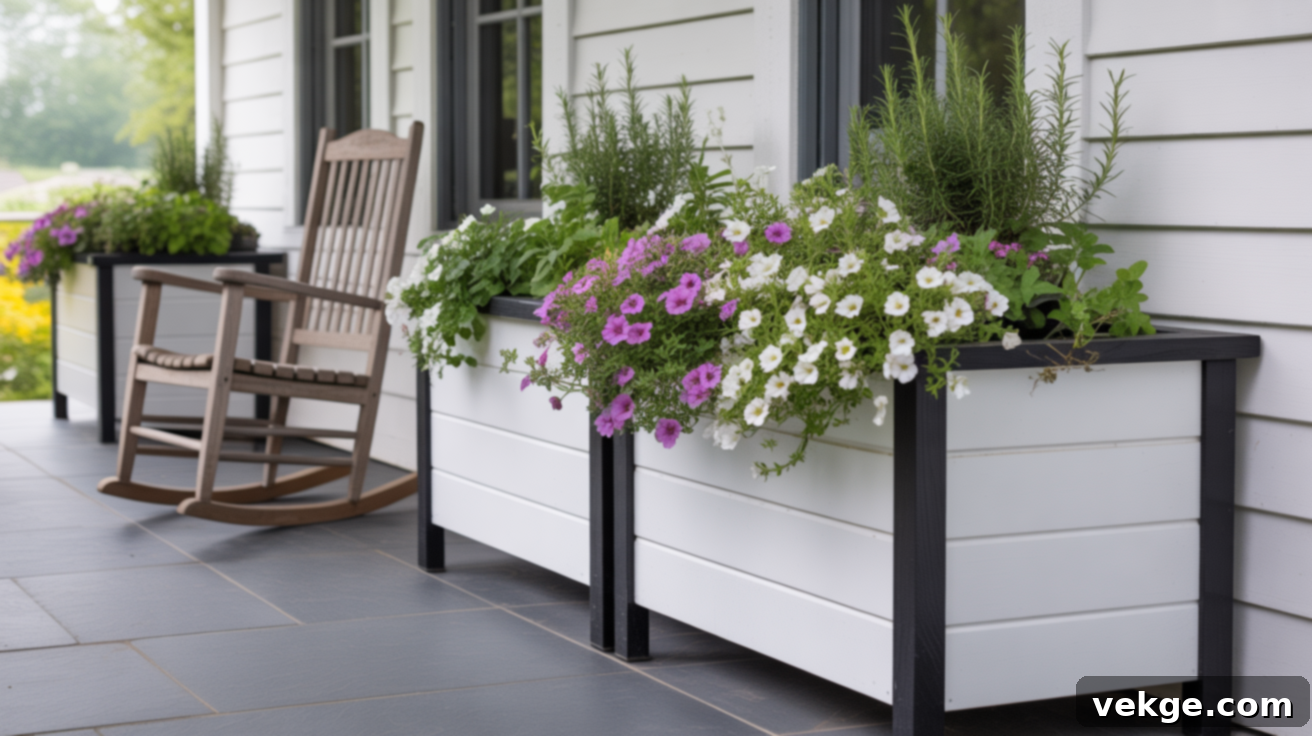
Crisp, clean white planter boxes with bold contrasting black trim instantly convey a sophisticated modern farmhouse style. These graphic containers provide strong architectural lines that anchor your planting areas, creating a polished and contemporary look. Against this striking backdrop, colorful plantings—be it vibrant annuals, lush perennials, or delicate herbs—truly take center stage, allowing their textures and hues to pop. This combination is both chic and incredibly versatile, suitable for front porches, patios, or along walkways.
5. Raised Garden Beds with Wooden Frames
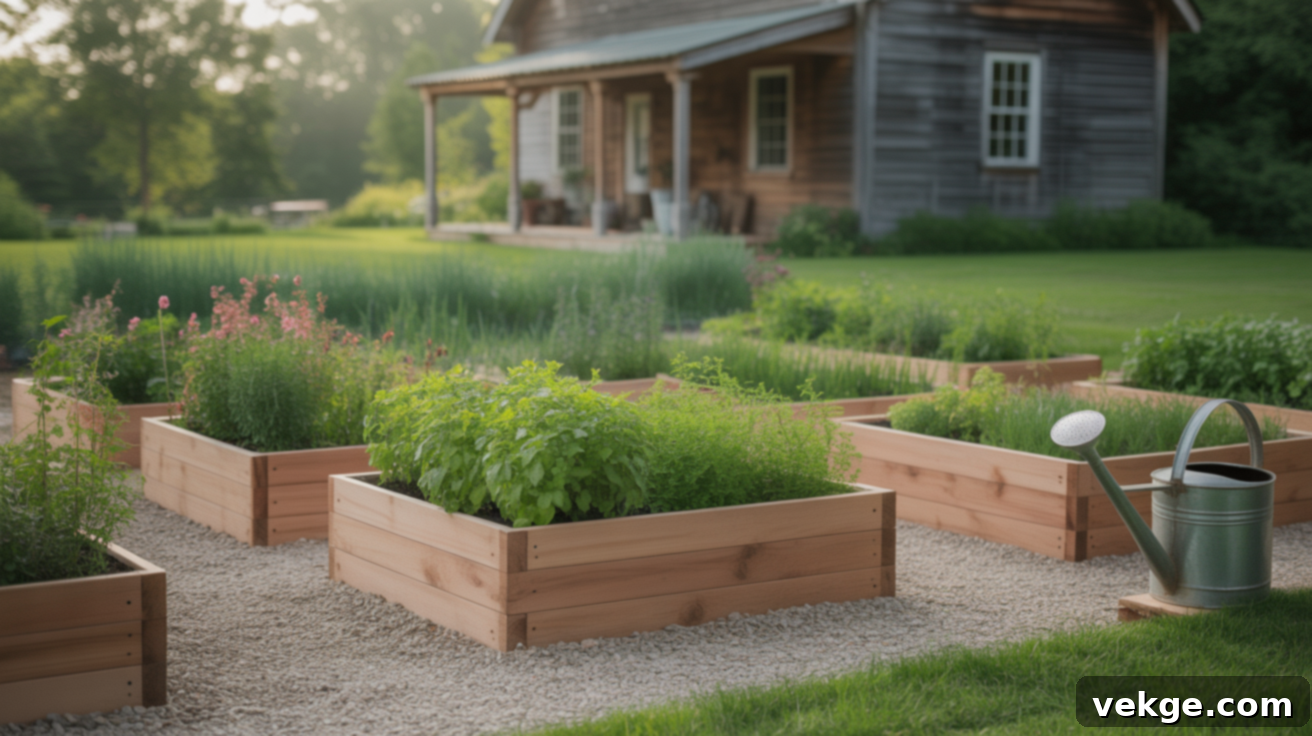
Elevated garden beds constructed from natural woods like cedar, cypress, or reclaimed timber create practical and highly productive growing spaces imbued with authentic farmhouse character. Their structured form adds architectural interest and defines planting zones, while also offering numerous practical benefits such as improved drainage, better soil quality, and enhanced accessibility for planting, tending, and harvesting. The warm tones of the wood beautifully complement the surrounding greenery, creating an inviting and organized garden area.
6. Galvanized Tub Planters
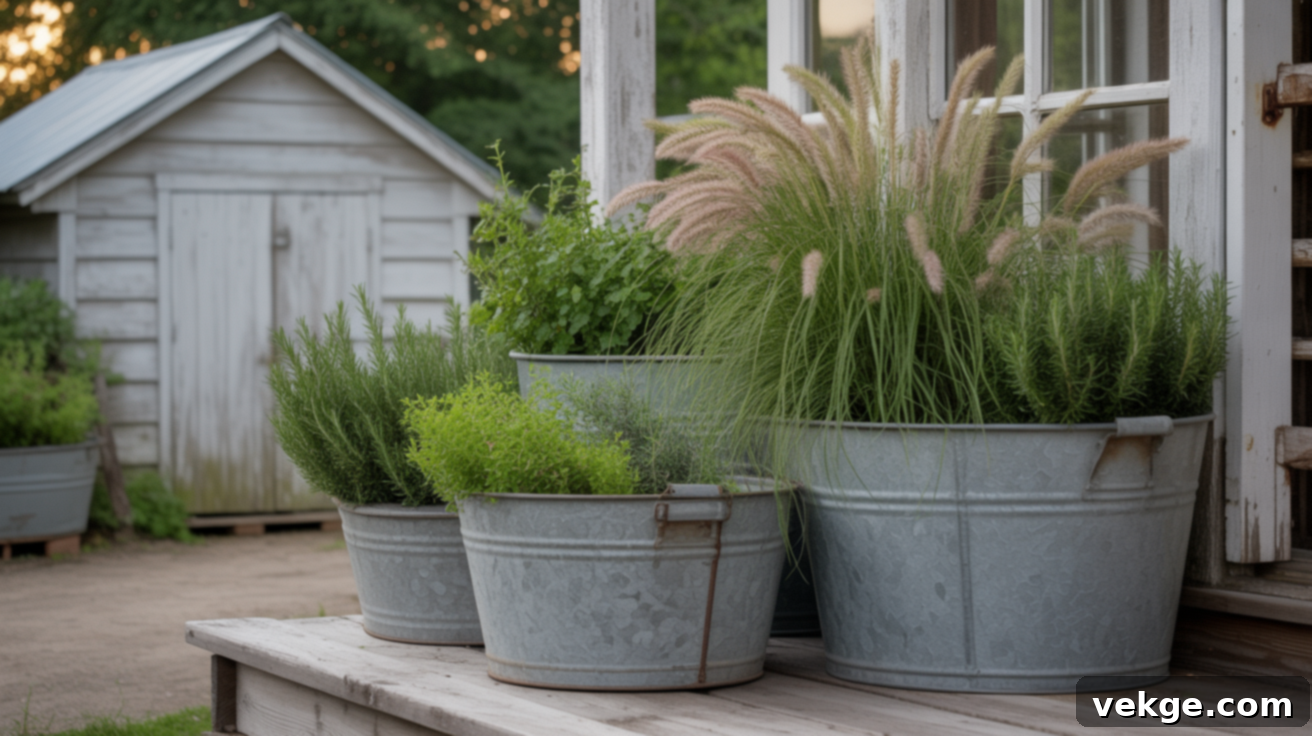
Vintage galvanized tubs bring an authentic touch of farm history and industrial charm to any garden setting. Their weathered metal surfaces introduce a unique texture and a rustic, repurposed aesthetic. These sturdy containers are excellent for growing a variety of plants, offering ample root depth. Before filling them with soil, remember to drill adequate drainage holes to prevent root rot. They are particularly well-suited for herbs, vegetables, or collections of vibrant annuals, adding a focal point that is both decorative and functional.
7. Simple Border Garden with Lavender and Grasses
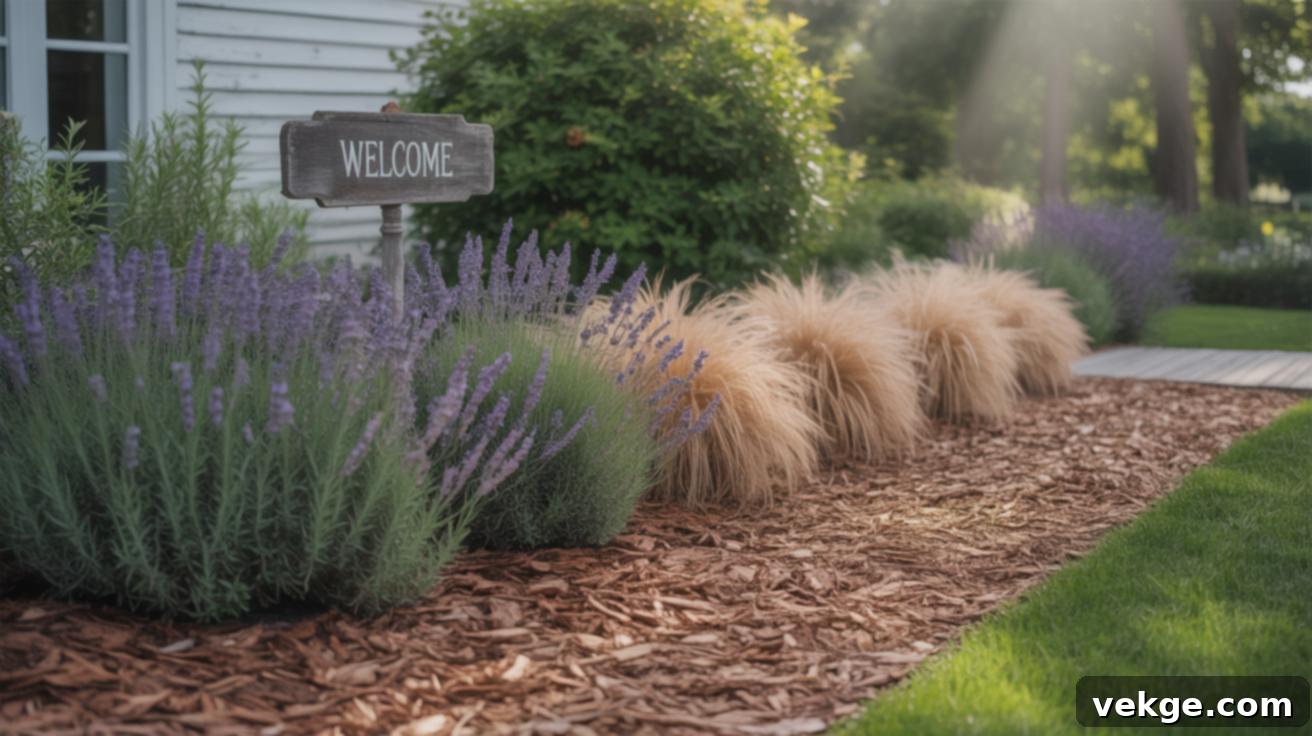
A simple yet elegant border garden featuring drought-tolerant lavender and various ornamental grasses creates a fragrant and visually appealing foundation for farmhouse landscapes. Lavender’s distinctive silver-blue foliage and beautiful purple blooms offer year-round interest and a delightful aroma. Paired with the soft movement and texture of ornamental grasses like ‘Karl Foerster’ feather reed grass or switchgrass, this combination delivers low-maintenance beauty, excellent drought resilience, and a relaxed, naturalistic look that perfectly embodies the modern farmhouse aesthetic. It’s an understated approach that maximizes impact.
Natural Plantings and Lawn Alternatives: Sustainable Greenery
These sustainable, low-maintenance greenery options replace traditional lawns with prairie-inspired plantings, natural meadows, and native species, enhancing the authentic farmhouse aesthetic while promoting ecological health.
8. Prairie-Style Wildflower Garden
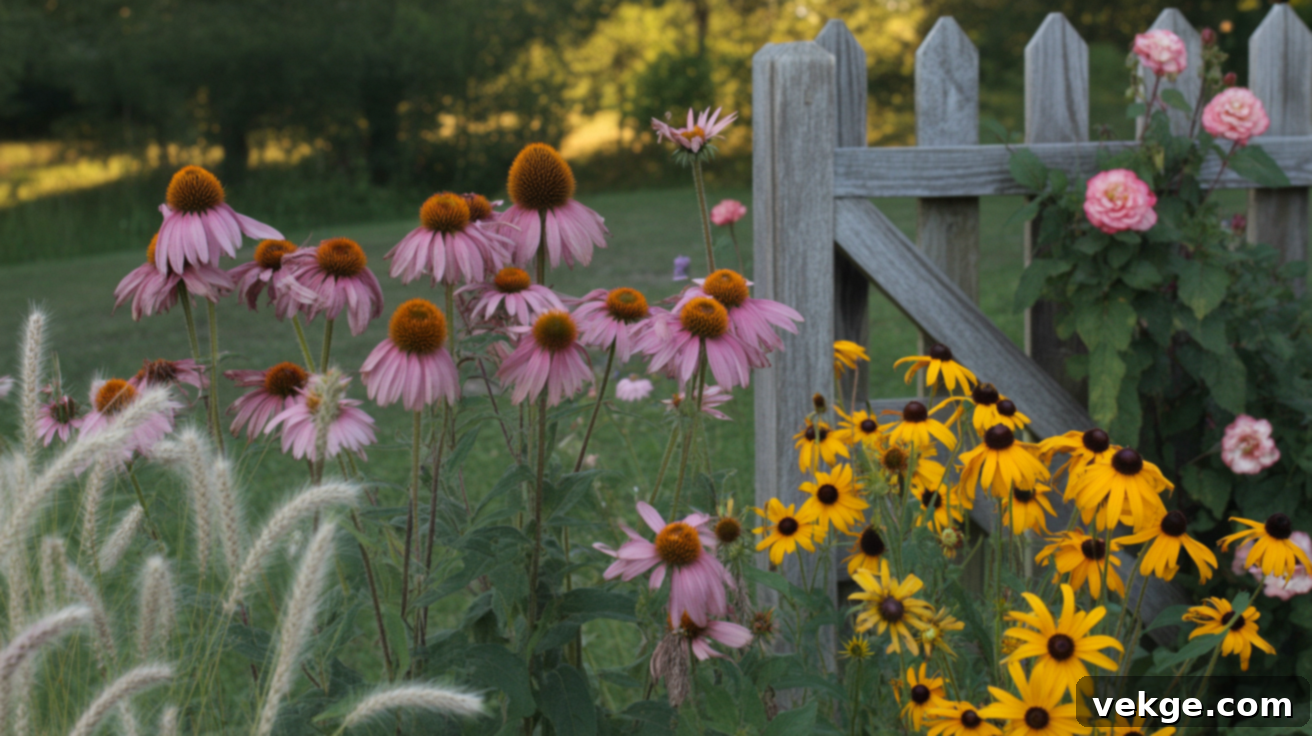
Embrace the romantic image of rural meadows by cultivating native wildflowers in naturalistic drifts. Species like cheerful black-eyed Susans, stately coneflowers, and late-season asters provide a continuous display of seasonal color, attracting and supporting vital pollinators. Integrating various ornamental grasses adds structure, movement, and a year-round textural element, mimicking the beauty of untouched prairies. This approach not only creates a breathtaking visual spectacle but also fosters biodiversity, requires minimal watering, and contributes to a healthier local ecosystem, aligning perfectly with sustainable farmhouse living.
9. Boxwood Borders for Structure
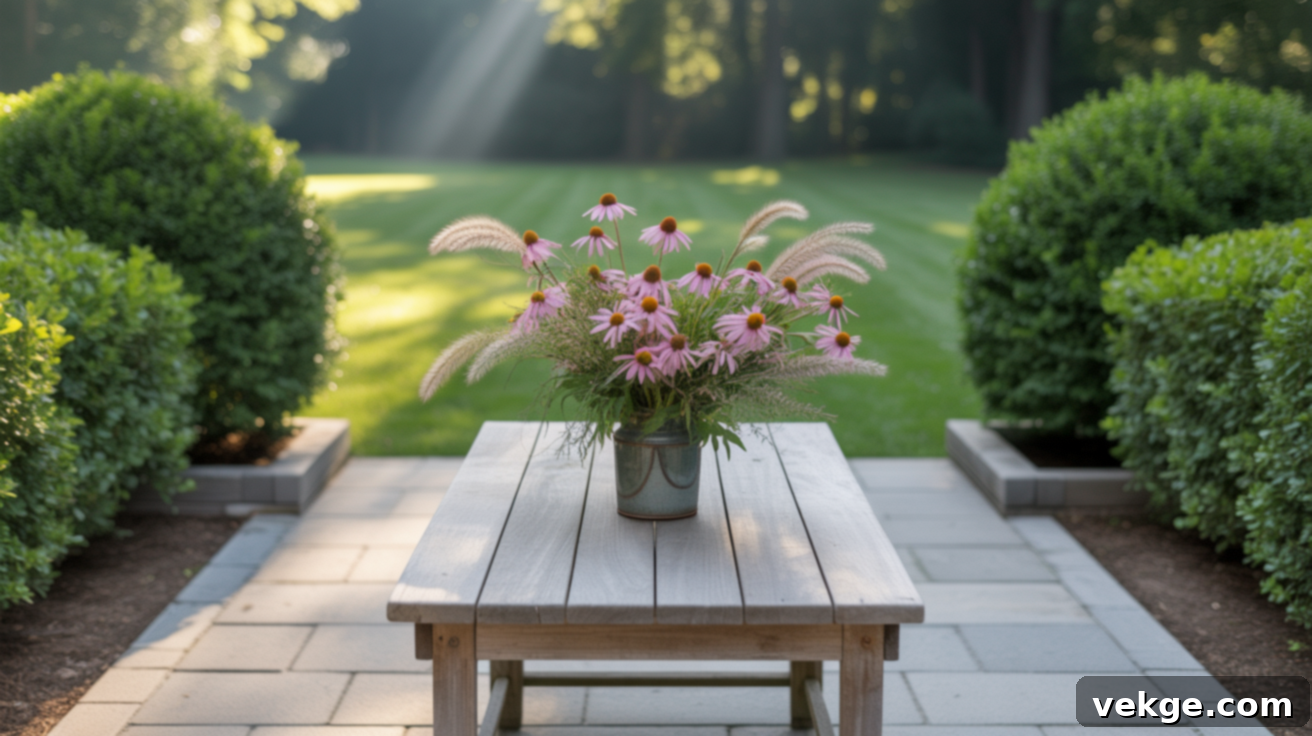
Low, precisely trimmed boxwood hedges are excellent for creating clean architectural lines that elegantly frame looser, more naturalistic plantings. Their evergreen structure provides year-round definition and formality, grounding the modern farmhouse design with a touch of classic sophistication. Whether used to outline garden beds, define pathways, or create a sense of enclosure, boxwoods offer a neat, tidy counterpoint to the wilder elements of prairie gardens, balancing tradition with contemporary clarity. They are versatile and relatively low-maintenance, requiring only occasional pruning to maintain their desired shape.
10. Herb Garden Near the Kitchen Door
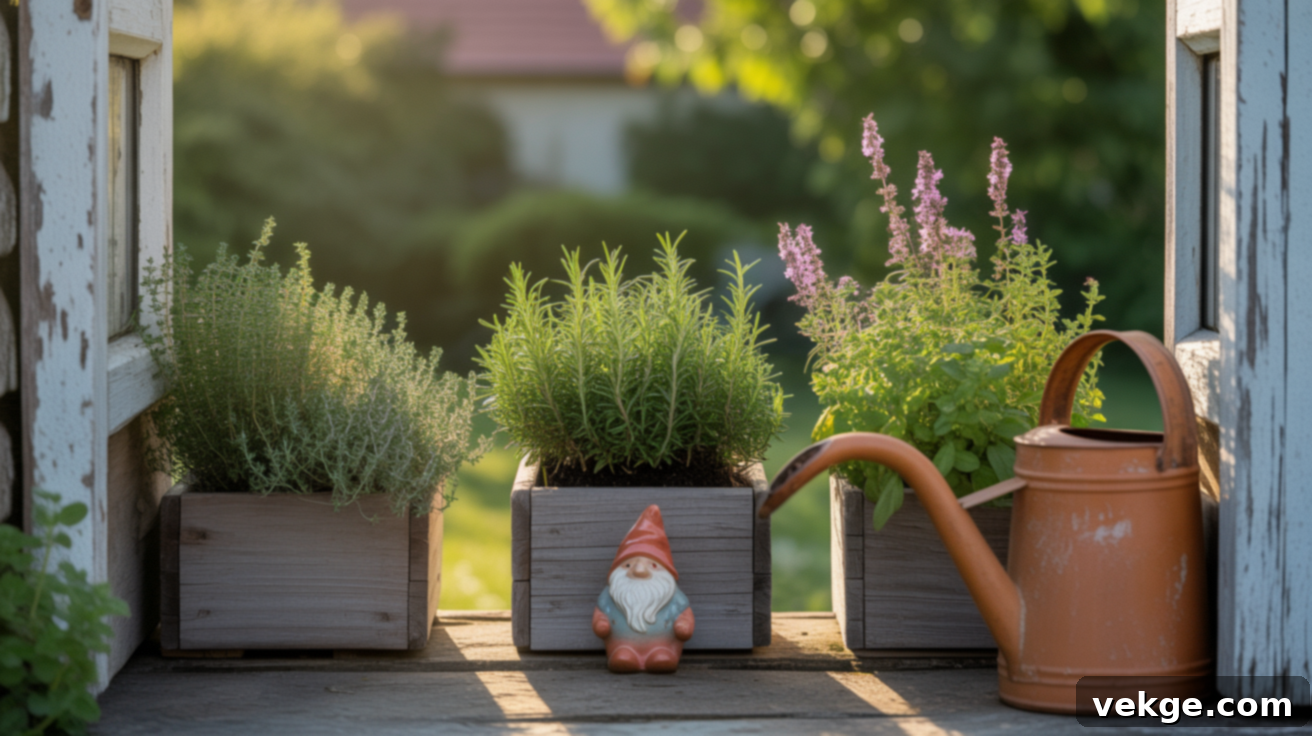
A compact and easily accessible herb garden positioned conveniently near the kitchen door beautifully blends practicality with farmhouse tradition. Arrange your herbs thoughtfully, placing taller varieties like rosemary or dill behind shorter ones such as thyme, oregano, or chives. Consider planting them in geometric patterns within defined beds or in charming containers for an organized look. Adding gravel paths between beds allows for easy harvesting, while the rustic appeal of the herbs themselves enhances the overall farmhouse aesthetic. This functional garden provides fresh ingredients just steps away, embodying the self-sufficiency of rural life.
Architectural & Decorative Features: Defining Your Space
These statement elements are crucial for defining your outdoor space with unmistakable farmhouse character, while simultaneously providing function, visual interest, and personality through carefully selected structures and ornamental details.
11. Vintage Water Pump Focal Point
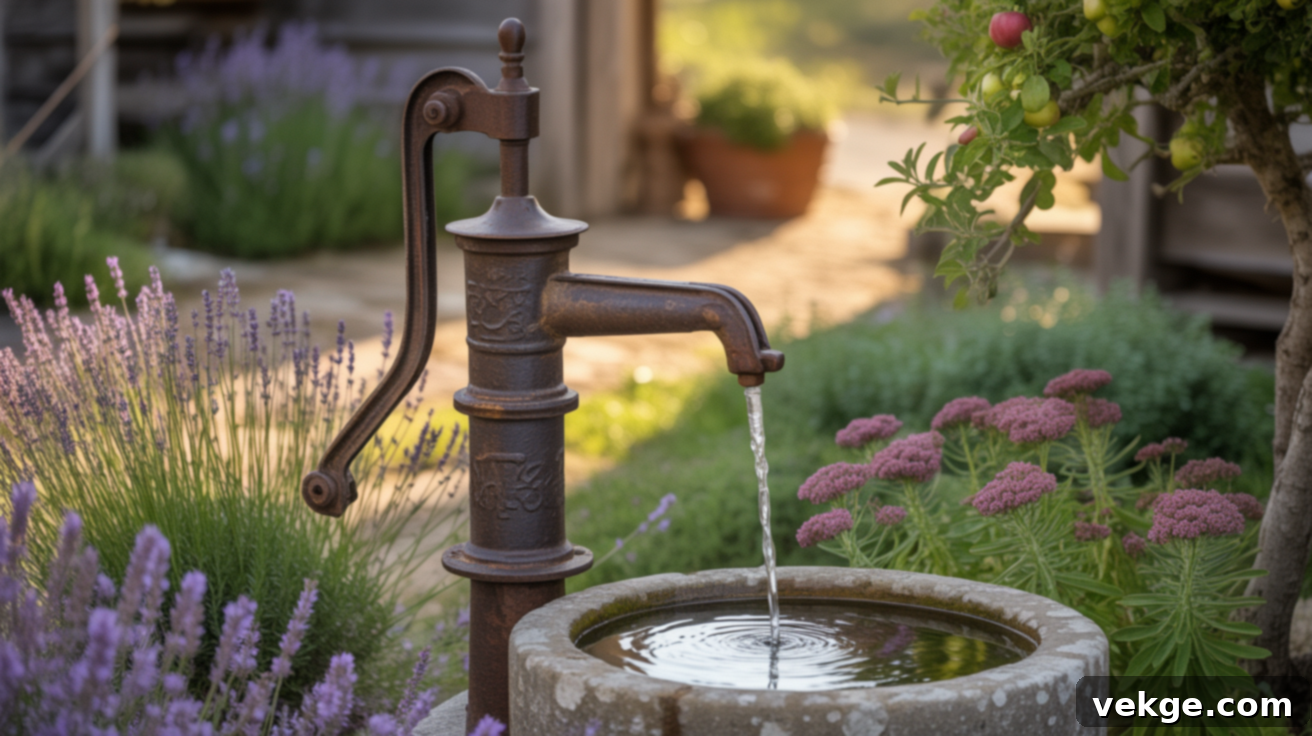
An antique hand pump serves as a compelling and authentic focal point, gracefully honoring agricultural heritage and adding a touch of nostalgic charm. Position this timeless piece within a thriving garden bed, surrounded by drought-tolerant plants like fragrant lavender, sturdy sedums, or graceful ornamental grasses. While often purely decorative, some can be restored to function as a unique water feature, adding a gentle trickle of water to the garden. Its weathered patina and rustic form provide a visual anchor that connects your modern landscape to its historical roots.
12. Shiplap-Inspired Outdoor Wall
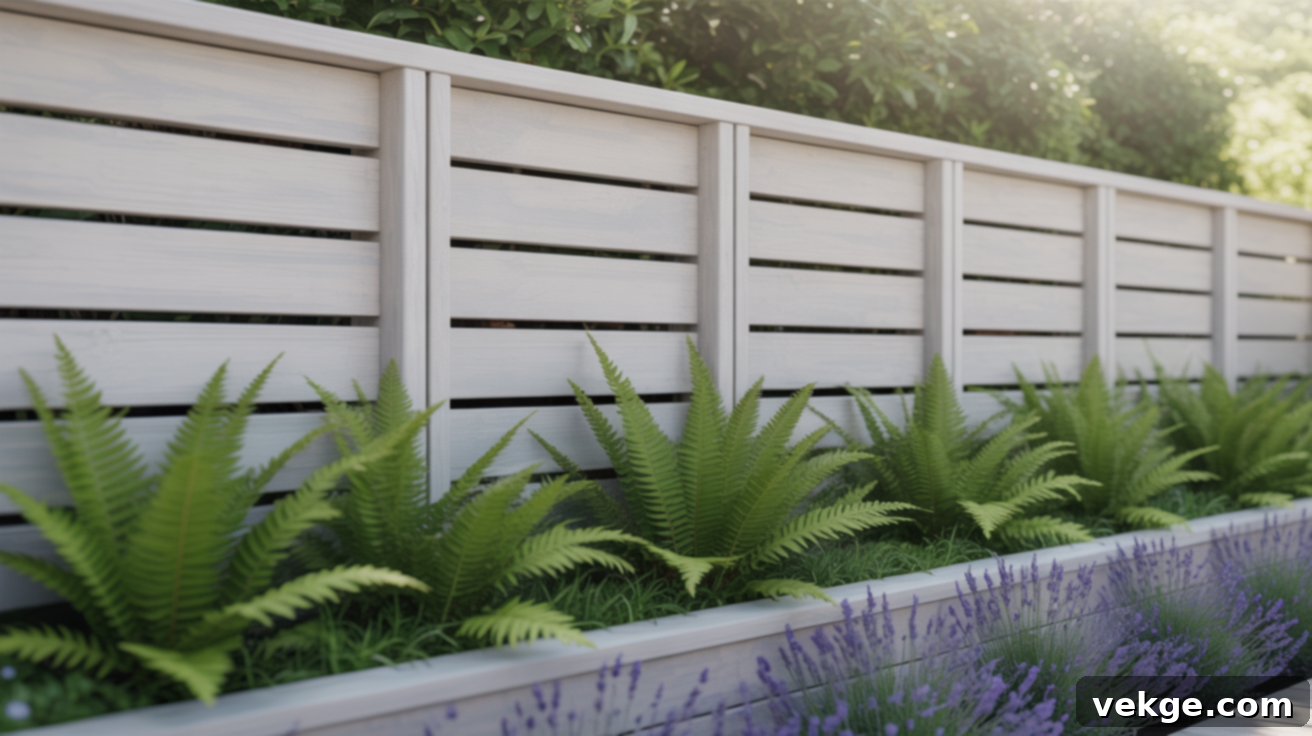
Horizontal wood planking, reminiscent of classic shiplap, instantly communicates a refined modern farmhouse style. Whether used for garden walls, privacy screens, or even an exterior accent on a shed, this linear pattern adds subtle texture and a clean, crisp backdrop. Paint it a bright white for a classic, airy feel, or leave the wood natural to allow it to weather gracefully, developing a beautiful, soft gray patina over time. This architectural element creates a cohesive look, tying your outdoor spaces visually to your home’s interior design.
13. Reclaimed Wood Pergola
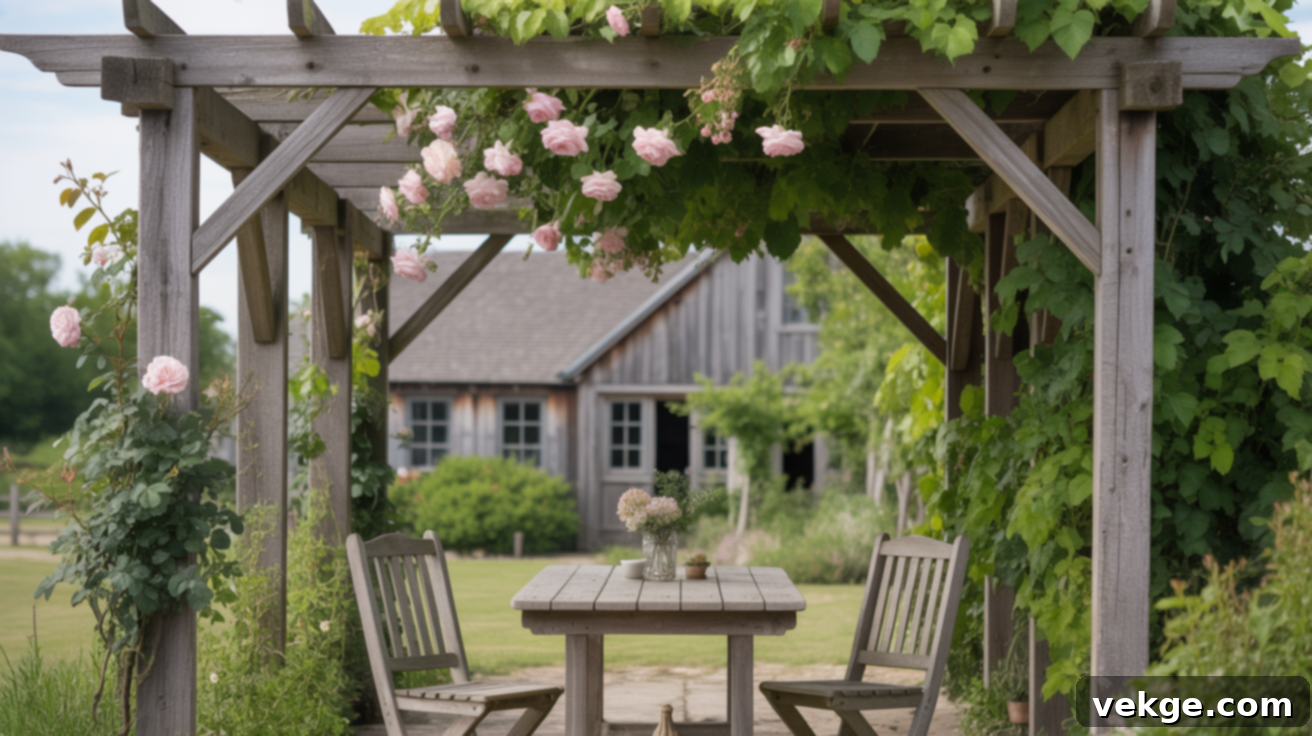
A pergola constructed from beautifully weathered timbers creates a powerful architectural definition for outdoor living areas, such as patios or seating zones. The overhead structure not only frames captivating views of your garden but also offers dappled shade, making the space more comfortable during sunny days. Allow climbing plants like wisteria, grapevines, or climbing roses to intertwine through the beams, adding natural beauty, fragrance, and further softening the structure. The use of reclaimed wood emphasizes sustainability and adds an irreplaceable sense of history and warmth.
14. Rustic Arbor or Trellis Entry
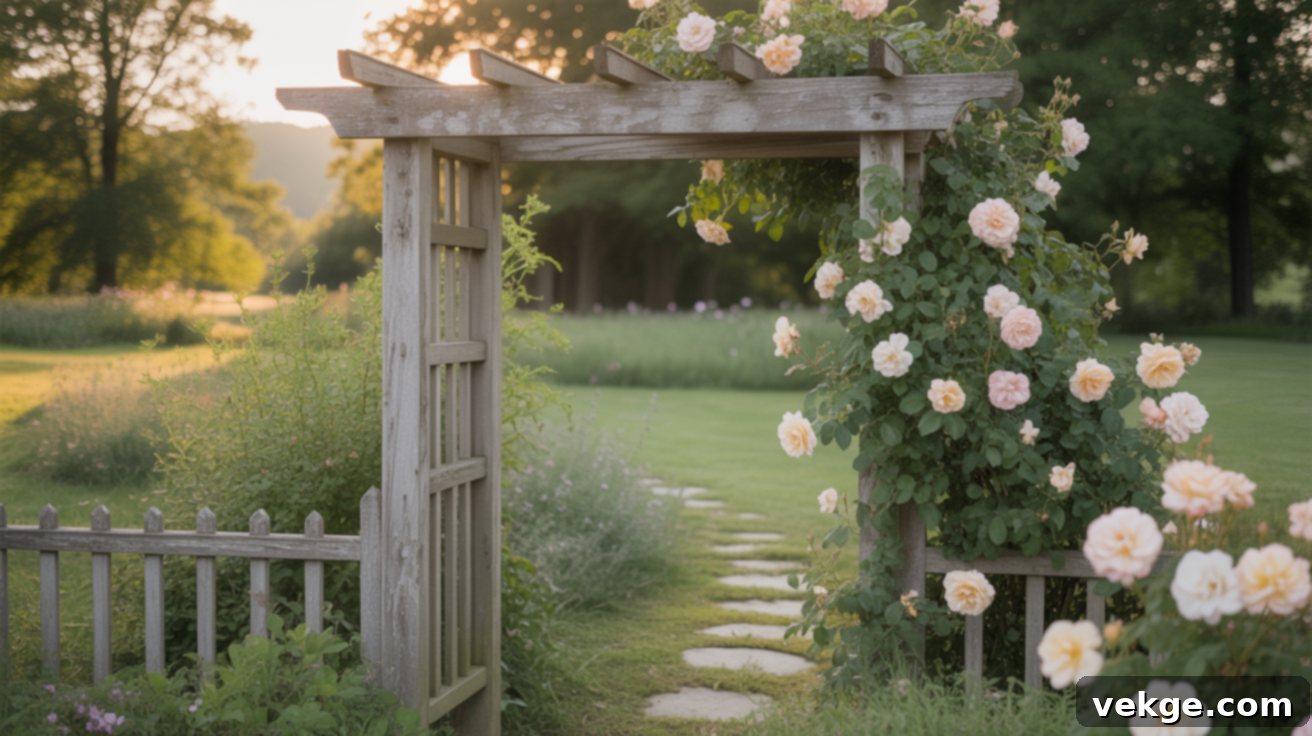
A simple yet elegant wooden arbor or trellis can beautifully mark transitions between different areas of your garden, creating a sense of arrival or a momentary pause. This architectural element acts as a welcoming gateway, inviting visitors to step into a new zone while providing essential support for climbing plants like clematis, honeysuckle, or rambling roses. Its rustic charm adds a romantic touch, enhancing the journey through your landscape and adding vertical interest without overwhelming the space. Choose natural wood for an authentic farmhouse feel.
15. Large Black-Framed Windows with Surround Planting
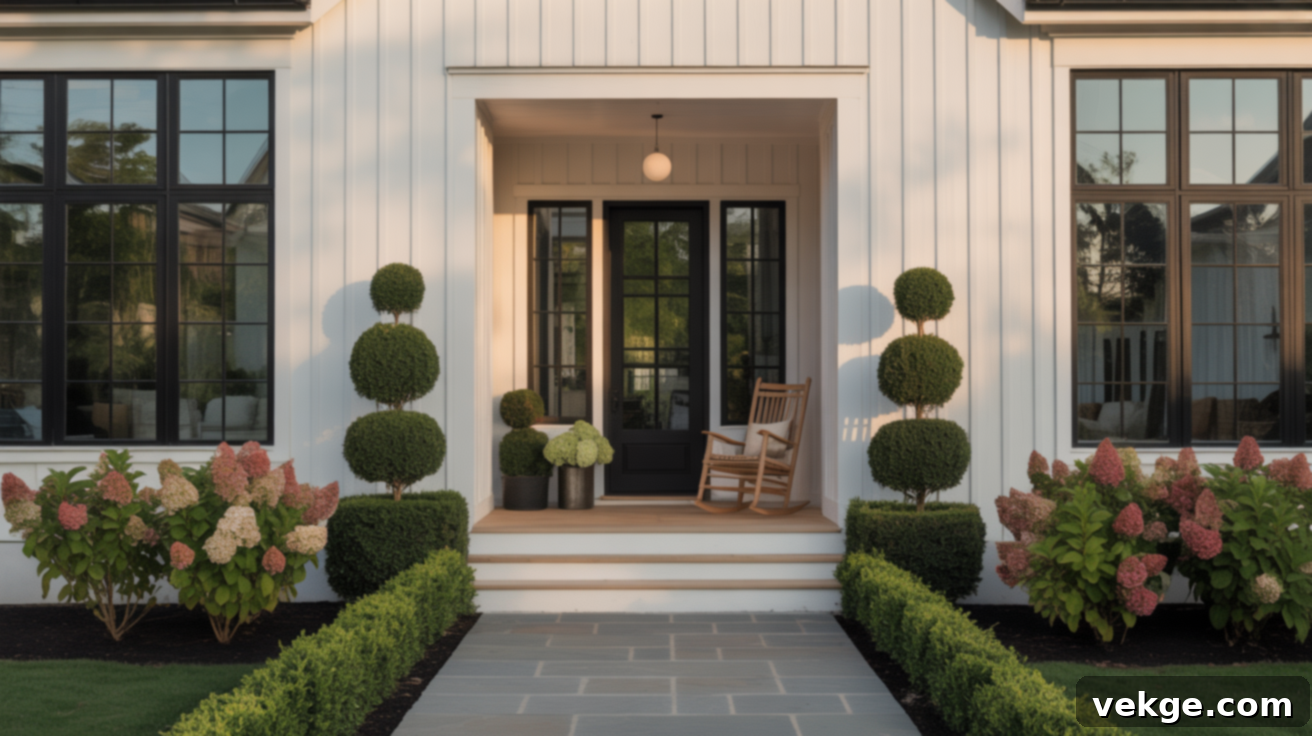
Bold black-framed windows are a hallmark of modern farmhouse architecture, creating dramatic visual statements and enhancing curb appeal. Extend this powerful design element into your landscape by carefully arranging plantings that complement and soften these striking openings. Consider tall, airy grasses, structured evergreen shrubs, or clusters of flowering perennials that draw the eye from the architecture into the garden. This approach blurs the lines between indoor and outdoor living, creating a harmonious and unified aesthetic where the house and garden mutually enhance each other.
16. Vintage Farm Equipment Display
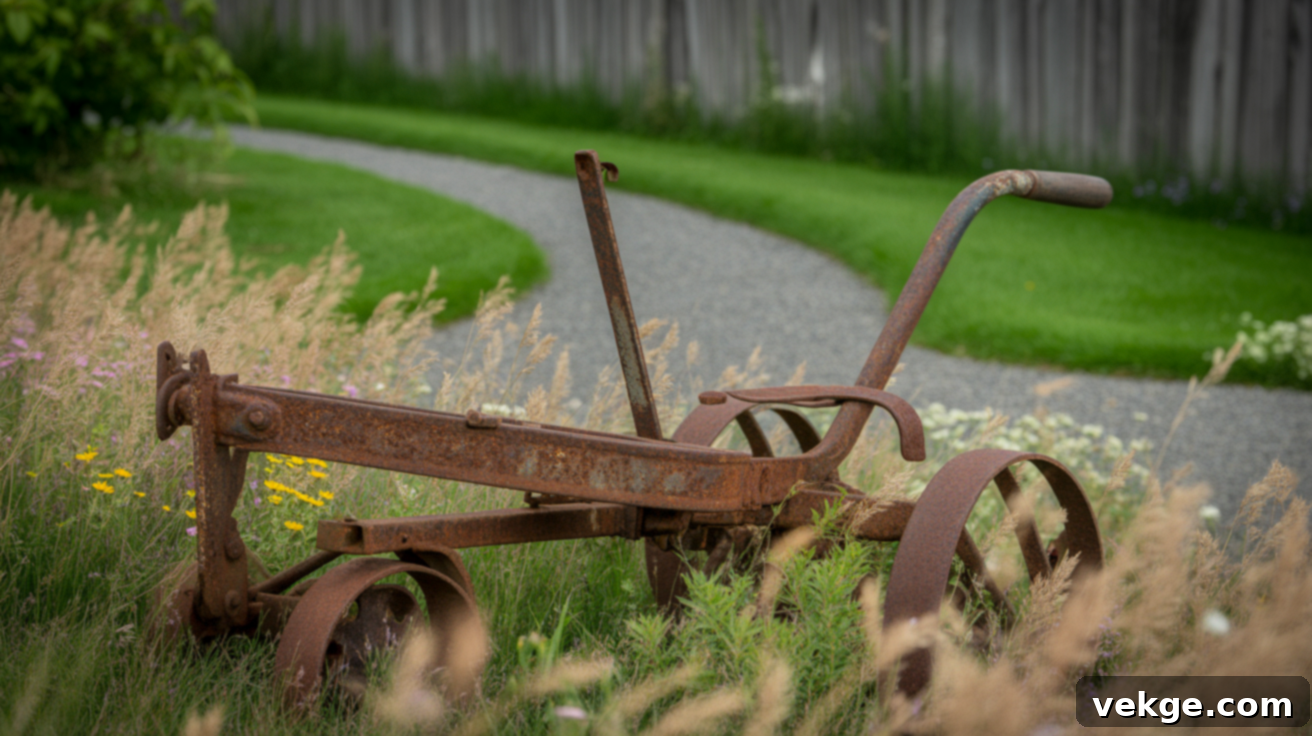
Thoughtfully integrated, repurposed agricultural tools such as old plows, charming wagon wheels, antique milk cans, or even weathered wheelbarrows can create truly authentic decorative elements. The key is to position these artifacts subtly, perhaps partially nestled among lush plantings or leaning against a rustic fence, rather than prominently displayed like museum pieces. This natural integration allows them to tell a story and add historical depth without feeling out of place or cluttered. These pieces celebrate the land’s heritage and reinforce the farmhouse narrative.
17. Wooden Bench with Metal Accents
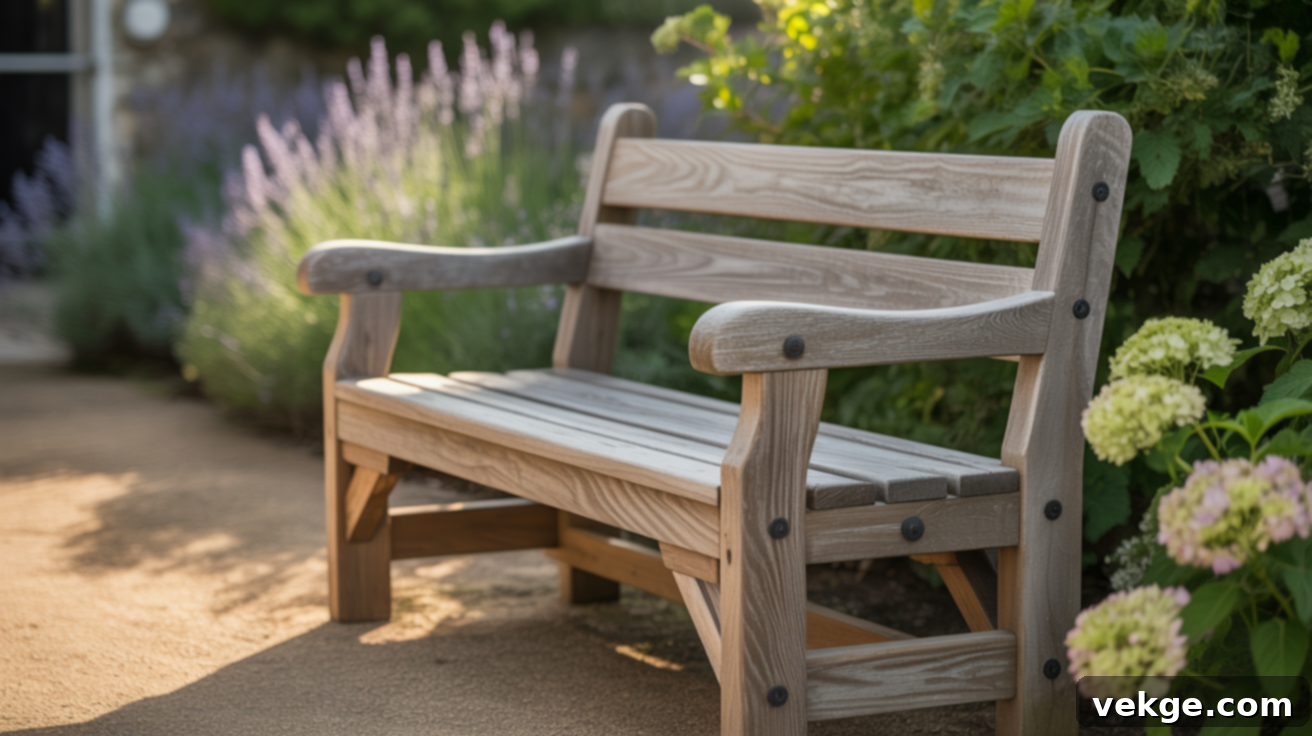
A sturdy timber bench, enhanced with black metal brackets or wrought-iron details, offers practical and inviting seating with undeniable farmhouse character. Perfect for a cozy garden nook, positioned under a shade tree, or strategically placed along a pathway, these benches provide welcoming rest spots. Choose chunky, durable, and naturally weathering wood like cedar or oak, which will age gracefully and acquire a beautiful patina over time. Add comfortable cushions or throws for an extra touch of warmth and hospitality, inviting relaxation and contemplation.
18. Textural Stone Wall
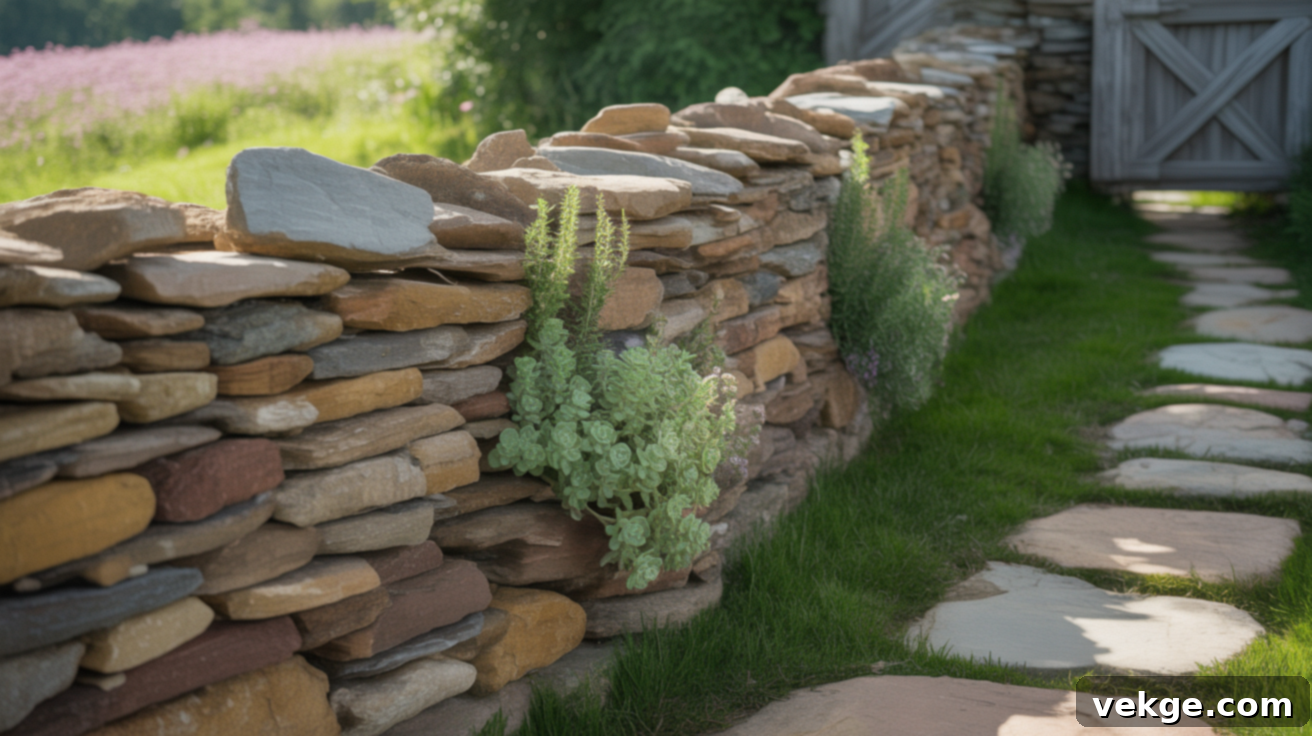
A dry-stacked fieldstone wall or one constructed with local mortared stone creates timeless boundaries with classic appeal and regional authenticity. These natural barriers serve multiple functions: they define garden beds, retain soil on slopes, and act as a beautiful backdrop. Referencing traditional agricultural land divisions, these walls also provide valuable habitat for beneficial insects and small wildlife. The varied textures and hues of natural stone add an organic warmth and robustness that is quintessential to the modern farmhouse aesthetic, grounding the landscape in its natural environment.
19. Weathered Wood Barn Door Gate
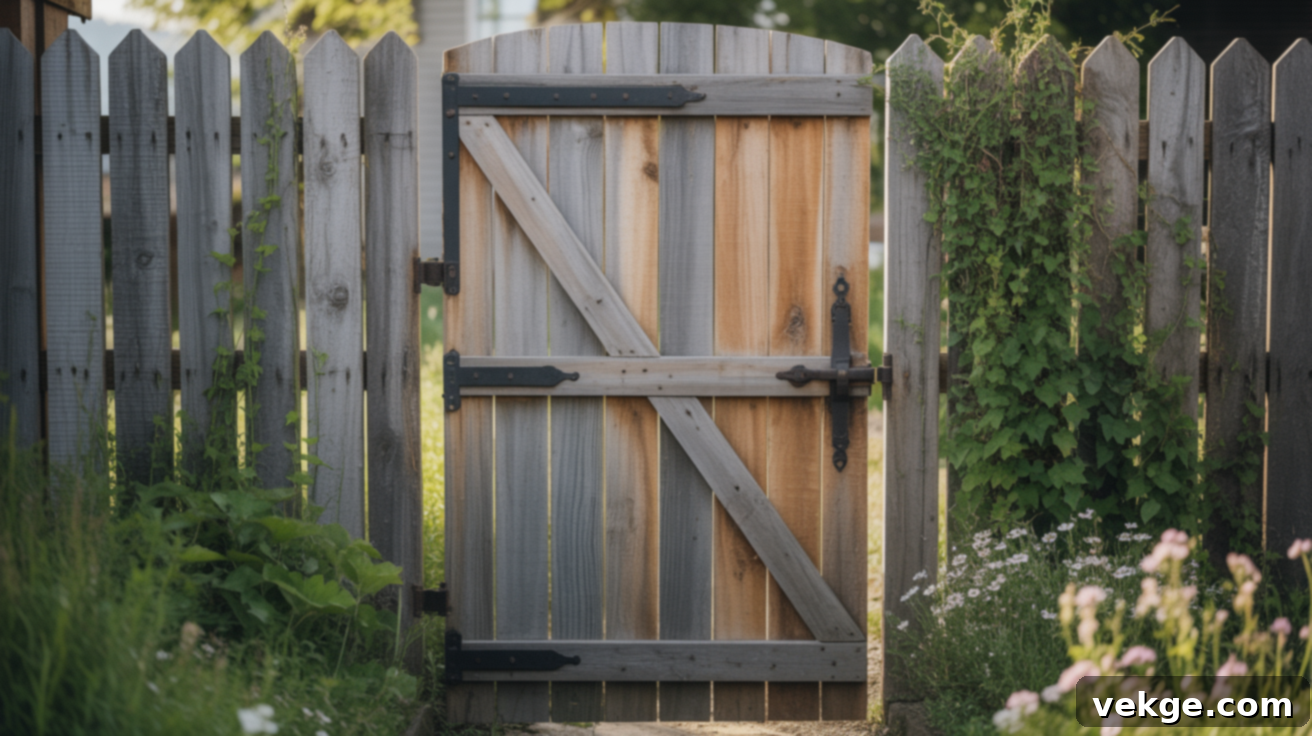
A repurposed sliding barn door, with its beautifully weathered wood, makes for an extraordinary and impactful garden gate. This feature instantly adds architectural character and an unmistakable touch of farmhouse heritage, creating a grand and unique entry point. Install it on robust black metal hardware that provides a striking contrast against the aged wood surfaces, further enhancing its visual appeal. Beyond its aesthetic charm, a barn door gate offers privacy and a secure enclosure for your garden, blending rustic functionality with modern design flair.
Smart & Affordable DIY Landscaping Tips for Modern Farmhouse Style
Transforming your yard into a modern farmhouse oasis doesn’t have to break the bank. With a little creativity and elbow grease, you can achieve stunning results on a budget. Here are some smart and cheap DIY tips to get you started.
1. Start Where It Matters Most: High-Impact Zones
Resist the urge to tackle your entire yard at once; this can quickly lead to overwhelm and overspending. Instead, focus your efforts on high-visibility areas that offer the most significant immediate impact, enhancing your home’s curb appeal. Begin with the front porch, the main walkway, or the entry path. These are the first areas visitors see, and improvements here will create a lasting first impression.
- Refresh with Mulch: A simple, inexpensive bag of fresh mulch applied to garden beds or around trees can instantly make the entire space look clean, tidy, and well-maintained. It also helps retain moisture and suppress weeds.
- Trim and Plant: Prune overgrown bushes and hedges for a neat appearance. Add a few new, strategically placed plants or potted flowers near your front door to introduce color and vibrancy.
- Address Structural Elements: Inspect and repair any wobbly front steps or railings. A fresh coat of paint or stain on these elements can dramatically improve their look and longevity.
2. Utilize What You Already Have: Repurpose and Recycle
You don’t need to purchase every new item. A treasure trove of potential landscaping materials might be lying around your garage, shed, or even your existing yard. Embracing repurposing is a cornerstone of the sustainable modern farmhouse aesthetic.
- Old Bricks and Stones: Leftover bricks can be laid to create charming garden edges or a rustic patio. Broken tiles or excess stones can be used to craft unique stepping stones or infill for paths.
- Wooden Crates and Pallets: Repurpose wooden crates, old buckets, or even discarded pallets into characterful planters or vertical garden displays. A bit of paint or distressing can elevate their look.
- Vintage Finds: Old furniture pieces, such as a worn-out dresser or a metal chair, can be creatively transformed into whimsical flower beds or unique plant stands with a little ingenuity.
- Garden Tools: An antique shovel, a rusty wagon wheel, or old milk cans can serve as charming decorative elements when thoughtfully integrated into your garden beds.
3. Choose the Right Plants: Native and Low-Maintenance
Selecting plants that are well-suited to your local climate and soil conditions is one of the smartest and most cost-effective decisions you can make. These are often native plants, which require less intervention once established.
- Research Native Species: Investigate which plant types thrive naturally in your specific region. Native plants are typically more resistant to local pests and diseases.
- Consult Local Experts: Visit a local plant nursery or botanical garden, or simply observe your neighbors’ successful gardens for inspiration and advice. They can recommend varieties that need less water and care.
- Prioritize Low-Maintenance: Opt for plants that don’t demand constant trimming, daily watering, or specialized soil amendments. Think drought-tolerant perennials, ornamental grasses, and sturdy shrubs that provide year-round interest.
4. Embrace DIY: Do the Work Yourself
Significant cost savings can be achieved by undertaking landscaping tasks yourself, rather than hiring professionals for every job. Many tasks are more manageable than they appear and can be learned with readily available online resources.
- Basic Planting: Digging holes, planting trees, shrubs, and flowers are fundamental gardening skills that are easy to master.
- Painting and Staining: Painting fences, staining decks, or touching up garden features are straightforward DIY projects that require basic tools and materials.
- Path Installation: Laying down mulch, gravel, or even simple stepping stones is a rewarding task you can complete in sections.
- Yard Maintenance: Trimming small trees, clearing overgrown plants, and weeding are all manageable with a few essential gardening tools and some dedicated time.
5. Shop Smart for Plants and Materials
Strategic shopping can significantly reduce your landscaping expenses. Plan your plant and material purchases like you would a grocery trip, always looking for value and opportunities to save.
- Hunt for Sales: Keep an eye out for sales at local nurseries, especially at the end of the planting season when they clear out inventory. Bargain bins can yield hidden gems.
- Exchange and Share: Don’t hesitate to ask neighbors, friends, or local gardening groups for plant cuttings, divisions, or seeds. Many gardeners are happy to share their abundance.
- Start from Seed: While more time-consuming, starting plants from seeds is significantly cheaper than buying established small plants. It offers a wide variety of choices too.
- Online and Community Resources: Explore online marketplaces, community forums, or neighborhood swap events for free or low-cost plants, materials, and even tools.
- Consider Bare-Root Plants: For trees, shrubs, and some perennials, purchasing bare-root options in the dormant season can be considerably cheaper than container-grown plants.
Conclusion: Cultivating Your Dream Modern Farmhouse Yard
I used to believe that creating a modern farmhouse yard meant embarking on a colossal and expensive undertaking. However, through experience, I’ve learned that it truly doesn’t have to be. The beauty of this style lies in its simplicity and the profound impact of thoughtful, incremental changes. By starting with a few deliberate steps—perhaps introducing a selection of resilient native plants, clarifying the lines of your pathways, or integrating meaningful reclaimed details—you’ll quickly notice your outdoor space transforming into a more inviting, functional, and surprisingly manageable environment.
Remember, there’s no need to achieve everything at once. I began my own journey with a simple gravel path and gradually built from there, allowing my garden to evolve organically. The key is to choose what feels right for your space and your lifestyle. Keep functionality at the forefront, embrace a relaxed and natural aesthetic, and let your yard grow into an outdoor haven that genuinely reflects your personality and seamlessly fits your needs. Your modern farmhouse landscape isn’t just a design choice; it’s a living, breathing extension of your home, designed for enjoyment and connection.
Need more inspiration for enhancing your living spaces? Don’t forget to explore other valuable resources on our website related to home decor, home improvement projects, sustainable living, and much more!
